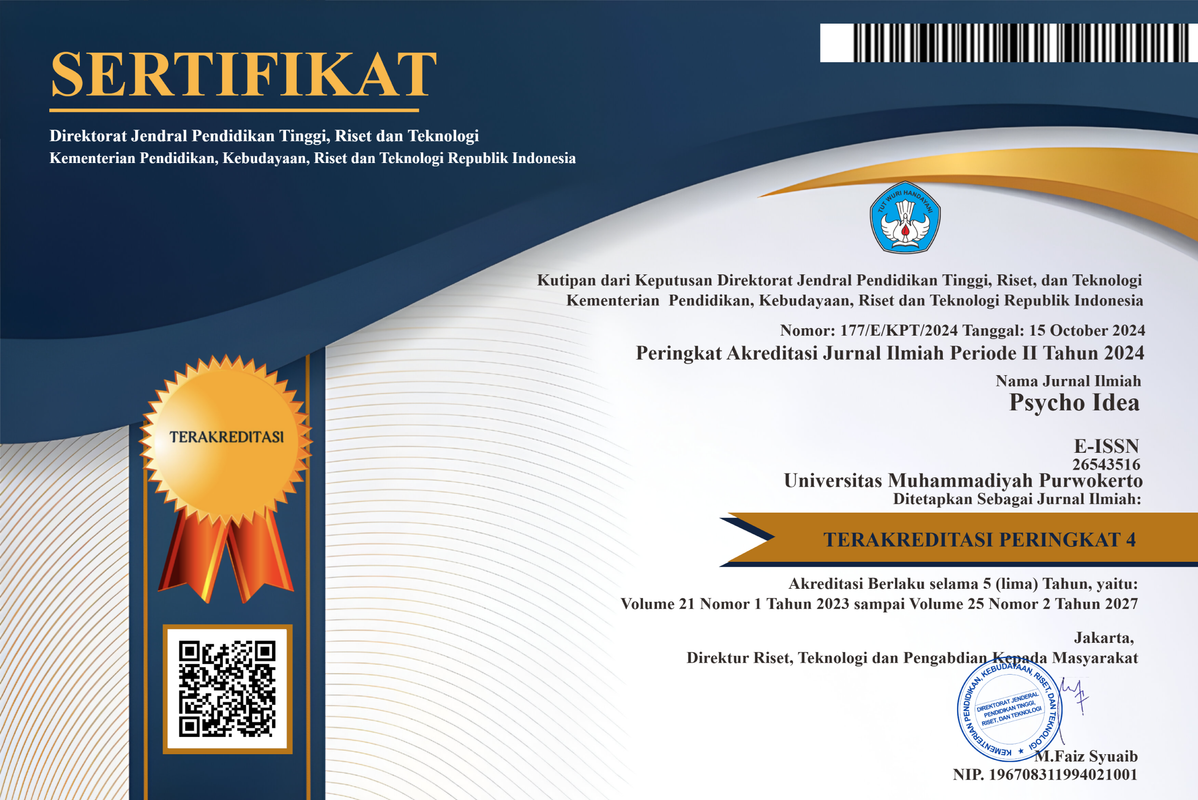Keberadaan Smartphone: Analisis Working Memory Capacity
DOI:
https://doi.org/10.30595/psychoidea.v22i1.21156Keywords:
OSpan Task, Ponsel, Working Memory CapacityAbstract
Aktivitas sehari-hari membutuhkan kinerja otak yang sangat kompleks, dan ini bergantung pada working memory capacity (WMC). Perbedaan individu mencerminkan WMC seseorang yang terbatas, dan tugas kognitif dapat diselesaikan jika kapasitas untuk menyimpan informasi saat diproses cukup. Tujuan penelitian kali ini ingin mengkonfirmasi apakah WMC seseorang dapat dipengaruhi oleh keberadaan smartphone-nya. Subjek sebanyak 16 orang (2 laki-laki, 14 perempuan, usia 18-21 tahun; mean usia=19.75). Subjek dibagi menjadi dua kelompok, yaitu kelompok smartphone di atas meja, dan kelompok smartphone di dalam tas. Pengukuran WMC menggunakan Operation Span Task (AOSPAN). Desain eksperimen yang digunakan adalah between-subject design. Hasilnya tidak terdapat perbedaan antar kedua kelompok perlakukan ditinjau dari nilai total OSpan (p=0.57>0.05). Sehingga tidak terdapat pengaruh keberadaan smartphone terhadap working memory capacity. Ada beberapa alasan yang menjadi faktor tidak terbuktinya pengaruh keberadaan smartphone terhadap working memory capacityReferences
Anggraini, F. T. (2023). Factors Affecting Working Memory Capacity: a Meta-Analysis Study. Jurnal Penelitian Pendidikan IPA,9(7), 256–262. https://doi.org/10.29303/jppipa.v9i7.4338
Blasiman, R.N., Was, C.A. (2018). Why Is Working Memory Performance Unstable? A Review of 21 Factors. Europe's Journal of Psychology Vol. 14 (1), 188–231, http://dx.doi.org/10.5964/ejop.v14i1.1472
Brady, T. F., Störmer, V. S., & Alvarez, G. A. (2016). Working memory is not fixed-capacity: More active storage capacity for real-world objects than for simple stimuli. Proceedings of the National Academy of Sciences of the United States of America, 113(27), 7459–7464. https://doi.org/10.1073/pnas.1520027113
Burgoyne, A. P., Hambrick, D. Z., & Altmann, E. M. (2019). Is working memory capacity a causal factor in fluid intelligence? Psychonomic Bulletin & Review, 26(4), 1333–1339. https://doi.org/10.3758/s13423-019-01606-9
Canale, N., Vieno, A., Doro, M. et al. (2019). Emotion-related impulsivity moderates the cognitive interference effect of smartphone availability on working memory. Sci Rep 9, 18519. https://doi.org/10.1038/s41598-019-54911-7
Cheever, N. A., Rosen, L. D., Carrier, L. M., & Chavez, A. (2014). Out of sight is not out of mind: The impact of restricting wireless mobile device use on anxiety levels among low, moderate and high users. Computers in Human Behavior, 37, 290–297. https://doi.org/10.1016/j.chb.2014.05.002
Du, X., Chen, C., Lin, H. (2022). The impact of working memory capacity on collaborative learning in elementary school students. Front. Psychol. 13:1027523. https://doi.org/10.3389/fpsyg.2022.1027523
Hu, Y., Kang, X., dan Mao, R. (2021). The Languages Impact on the Stroop Effect: Comparison in Chinese and English. Advances in Social Science, Education and Humanities Research, volume 615. Proceedings of the 2021 4th International Conference on Humanities Education and Social Sciences (ICHESS 2021).
Ku Y. (2018). Selective attention on representations in working memory: cognitive and neural mechanisms. PeerJ, 6, e4585. https://doi.org/10.7717/peerj.4585
Kwon, M., Kim, D.-J., Cho, H., & Yang, S. (2013). The Smartphone Addiction Scale: Development and Validation of a Short Version for Adolescents. PLoS ONE, 8(12), e83558. https://doi.org/10.1371/journal.pone.0083558
Lepp, A., Barkley, J. E., & Karpinski, A. C. (2014). The relationship between cell phone use, academic performance, anxiety, and Satisfaction with Life in college students. Computers in Human Behavior, 31, 343–350. https://doi.org/10.1016/j.chb.2013.10.049
Lepp, A., Li, J., Barkley, J. E., & Salehi-Esfahani, S. (2015). Exploring the relationships between college students’ cell phone use, personality and leisure. Computers in Human Behavior, 43, 210–219. https://doi.org/10.1016/j.chb.2014.11.006
Morey, R. D. (2011). A Bayesian hierarchical model for the measurement of working memory capacity. Journal of Mathematical Psychology, 55(1), 8–24. https://doi.org/10.1016/j.jmp.2010.08.008
Nahm, F. S. (2016). Nonparametric statistical tests for the continuous data: the basic concept and the practical use. Korean J Anesthesiol, 69(1): 8-14. http://dx.doi.org/10.4097/kjae.2016.69.1.8
Shipstead, Z., Harrison, T. L., & Engle, R. W. (2016). Working Memory Capacity and Fluid Intelligence: Maintenance and Disengagement. Perspectives on psychological science : a journal of the Association for Psychological Science, 11(6), 771–799. https://doi.org/10.1177/1745691616650647
Skowronek, J., Seifert, A., & Lindberg, S. I. (2023). The mere presence of a smartphone reduces basal attentional performance. Scientific Reports, 13(1). https://doi.org/10.1038/s41598-023-36256-4
Stevens, C., & Bavelier, D. (2012). The role of selective attention on academic foundations: a cognitive neuroscience perspective. Developmental cognitive neuroscience, 2 Suppl 1(Suppl 1), S30–S48. https://doi.org/10.1016/j.dcn.2011.11.001
Thornton, B., Faires, A., Robbins, M., dan Rollins, E. (2014). The Mere Presence of a Cell Phone May Be Distracting: Implications for Attention and Task Performance. Social Psychology, 45 (6). http://dx.doi.org/10.1027/1864-9335/a000216
Ward, A.F., Duke, K., Gneezy, A., Bos, M.W. (2017). Brain Drain: The Mere Presence of One’s Own Smartphone Reduces Available Cognitive Capacity. JACR, volume 2, number 2. http://dx.doi.org/10.1086/691462.
Wilhelm, O., Hildebrandt, A., Oberauer, K. (2013). What is working memory capacity, and how can we measure it? http://dx.doi.org/10.3389/fpsyg.2013.00433
Wilmer, H. H., Sherman, L. E., & Chein, J. M. (2017). Smartphones and Cognition: A Review of Research Exploring the Links between Mobile Technology Habits and Cognitive Functioning. Frontiers in Psychology, 8, 605. https://doi.org/10.3389/fpsyg.2017.00605
Downloads
Published
Issue
Section
License
Authors published in this journal agree to the following terms:
- The copyright of each article is retained by the author (s) without restrictions
- The journal allows the author(s) to retain publishing rights without restrictions
- The author grants the journal the first publication rights with the work simultaneously licensed under the Creative Commons Attribution License, allowing others to share the work with an acknowledgment of authorship and the initial publication in this journal.
- Authors may enter into separate additional contractual agreements for the non-exclusive distribution of published journal versions of the work (for example, posting them to institutional repositories or publishing them in a book), with acknowledgment of their initial publication in this journal
- Authors are permitted and encouraged to post their work online (For example in the Institutional Repository or on their website) before and during the submission process, as this can lead to productive exchanges, as well as earlier and larger citations of published work
- Articles and all related material published are distributed under a Creative Commons Attribution-4.0 International Public License (CC - BY 4.0).
License
Psycho Idea is licensed under a Creative Commons Attribution- 4.0 International Public License (CC - BY 4.0).
You are free to :
Share — copy and redistribute the material in any medium or format
Adapt — remix, transform, and build upon the material for any purpose, even commercially











